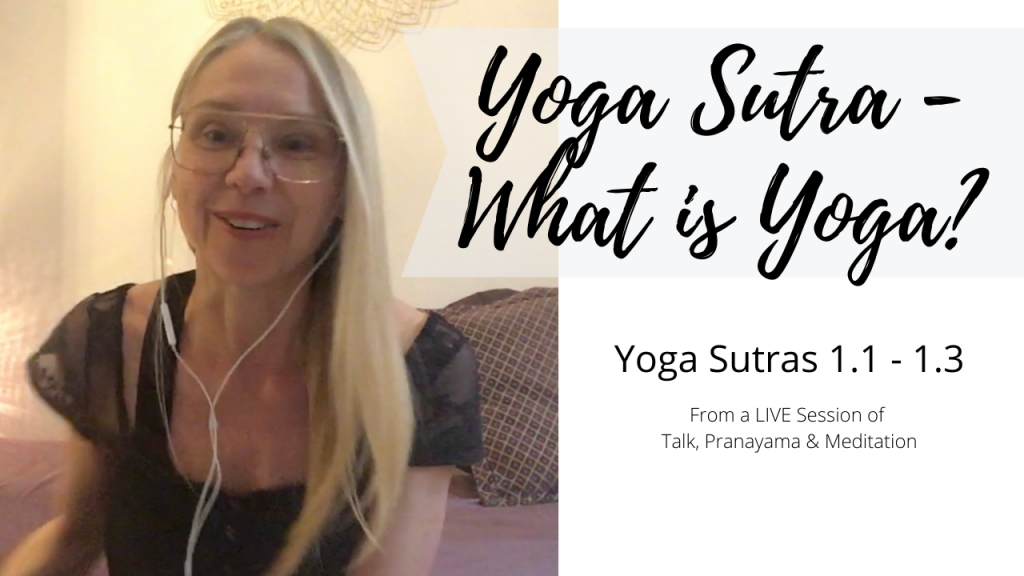
Click the photo to see the video.
Yoga Sutra 1.1 ‘atha yoga-anushāsanam.’ Now [begins the] exposition of Yoga.
I love the teachings in the yoga sutras. I’ve read them over and over to inform my life, help me see myself clearer and when ‘stuck’ contemplate how to find wholesome solutions. If they interest you, start with this first sutra…we start the ‘exposition’ of yoga NOW. The dictionary definition of exposition – a comprehensive description and explanation of an idea or theory. In my opinion, it isn’t about being able to spout out a lot of fancy Sanskrit words that matters; it’s being able to put the information to use in a practical, concrete, every day way that will magically reveal the beauty of your inner being!
Sutra 1.2 [yogash citta-vritti-nirodhah.] Yoga is the restraint of the activities of the mind.
So, this is the second sutra, out of 196. It’s the summary; the goal of yoga. Let’s break it down. Yoga, we all know its origins from ‘to yoke’. It’s a discipline used to make UNION. ONENESS. A whole topic in itself, but we won’t go there today. Citta, the sum contents of our consciousness: mind, intellect and ego. Vritti. Love this one! Whirls!!! Wow, don’t we all feel that our citta is continually whirling? Spinning? Never ending thoughts that seem to be out of our control. I know I do!!!! Nirodhah, restraining, stopping, controlling. Therefore, that sutra can be put into our language like this: Yoga is trying to calm the whirling thoughts of the mind. Next time you are doing your asana practice, try noticing the background noise (from your own head). What is it saying to you? ‘You can do better.’ ‘My practice is better than yesterday.’ ‘Oh my god, this is hard.’ ‘Wow, great drop back today.’ ‘I should stop this practice, it’s boring.’ ‘Just ignore the pain in my knee.’ ‘What am I going to eat for breakfast’ Blah, blah, blah. Be aware! This sutra IS NOT implying to numb out and become dimwitted. We will see as the sutras proceed; it is a much more profound state than just ‘not thinking’. Not thinking can happen when we are over tired, over working in our asana practice, dull-minded.
Sutra 1.3 [tadā drashtuh svarūpe ‘vasthānam.] Then [there is] the appearance of the Seer in [its] essence.
What does this mean? Who is the Seer and what is its essence? It’s what a lot of us call our ‘True Self’. The part of us that sees but doesn’t get entangled with the external world. The ego/mind/intellect is the go-between between the Seer and the external objective world. When the ego/mind/intellect are clouded then we cannot see deep, where the True Self resides. Essentially, in this third sutra, Patanjali is describing what we experience when the vrittis of the mind are stilled; we will be able to see clearly our True Self. This is heavy with meaning, experiencing the ‘Seer in its essence’ will give us a whole new insight into who we are and our play in the world. I like to look at the sutras on many different levels. There are the deep, esoteric levels that enrich our spiritual life and there are the levels that we can apply in the here and now to our daily life; the level that will enrich our daily interactions with ourself and others. Think of it, when we can begin to still the vrittis, we are better able to concentrate, better able to see our weird little habits, prejudices, judgements, see our egoic self as it truly is. See our contribution to the interconnectedness of the world. See how everything else contributes to us, again showing us the interconnectedness. I believe it is important to use this sutra to remind us to try to see clearer, to see the real essence behind a situation, behind other people. Other PEOPLE. Other ANIMALS. Other NATURE.
Translations of the sutra by Georg Feuerstein with whom I studied before he passed away. He brought a lot of inspiration to my path!

